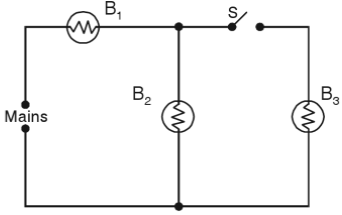1. A kilowatt hour is the unit of
(i) energy
(ii) power
(iii) electric charge
(iv) electric current
Answer: (i) energy
2. Heat produced in a conductor depends
(i) inversely on time
(ii) directly on time
(iii) both (i) and (ii)
(iv) none of the above
Answer: (ii) directly on time
3. If potential difference across a conductot of a material of resistivity ρ remains constant, then heat produced in the conductor is proportional to
(i) ρ
(ii) ρ2
(iii) 1/√ρ
(iv) 1/ρ
Answer: (iv) 1/ρ
4. One kilowatt hour is equal to
(i) 36 x 103J
(ii) 103J
(iii) 36 x 105 J
(iv) 105 J
Answer: (iii) 36 x 105 J
5. The heater element in an electric iron is made of
(i) nichrome
(ii) iron
(iii) tungsten
(iv) constantan
Answer: (i) nichrome
6. The current in a 960 W, 240 V heater operated at 200 V is
(i) 0.25 A
(ii) 3/10 A
(iii) 2.5 A
(iv) 10/3 A
Answer: (iv) 10/3 A
7. Three electric bulbs 40 W, 60 W and 100 W are designed to work on a 220 V mains. Which bulb will burn most brightly if they are connected in series across 220 V mains?
(i) 60 W
(ii) 40 W
(iii) 100 W
(iv) all bulbs will bum equally brightly
Answer: (ii) 40 W
8. Two electric bulbs have tungsten filament of the same length. If one of them gives 60 W and the other 100 W, then,
(i) 100 W bulb has thicker filament
(ii) 60 W bulb has thicker filament
(iii) both filaments are of the same thickness
(iv) information insufficient
Answer: (i) 100 W bulb has thicker filament
9. Two electric lamps of 40 W each are connected in parallel. The power consumed by the combination is
(i) 20 W
(iii) 80 W
(ii) 60 W
(iv) 100 W
Answer: (iii) 80 W
10. The time required for 1kW heater to raise the temperature of 10 litres of water through 10°C is
(i) 210 sec
(ii) 840 sec
(iii) 42 sec
(iv) 420 sec
Answer: (iv) 420 sec
11. The electric lamps 40 W, 220 V each are connected in series across 220 V. The power consumed by the combination is
(i) 80 W
(ii) 20 W
(iii) 160 W
(iv) 40 W
Answer: (ii) 20 W
12. Two bulbs, 100 W, 250 V and 200 W, 250 V, am connected in parallel across a 500 V line. Then,
(i) 100 W bulb will be fused
(ii) 200 W bulb will be fused
(iii) Both bulbs will be fused
(iv) No bulb will be fused
Answer: (iii) Both bulbs will be fused
13. Two bulbs, 100 W, 250 V and 200 W, 250 V are connected in series to a 500 V line. Then,
(i) 100 W bulb will be fused
(ii) 200 W bulb will be fused
(iii) both bulbs will be fused
(iv) no bulb will be fused
Answer: (i) 100 W bulb will be fused

14. Three bulbs B1, B2 and B3 are connected to the mains as shown in above Fig. If B3 is disconnected from the circuit by opening switch S, then incandensence of bulb B1 will
(i) decrease
(i) increase
(iii) No change
(iv) cannot say
Answer: (i) decrease
15. You are given the following electrical appliances (a) 1 kW, 250 V electric heater (b) 1 kW, 250 V, electric kettle (c)1 kW, 250 V, electric bulb. Which of these has the highest resistance ?
(i) heater
(ii) kettle
(iii) bulb
(iv) all have equal resistances
Answer: (iv) all have equal resistances
16. If current in an electric bulb drops by 2%, then power decreases by
(i) 2%
(ii) 4 %
(iii) 1 %
(iv) 16%
Answer: (ii) 4 %
17. Two bulbs of 500 W and 300 W are manufactured to operate on 220 V line. The ratio of resistance of 500 W bulb to that of 300 W bulb is
(i) 5 : 3
(ii) 9 : 25
(iii) 3 : 5
(iv) 25 : 9
Answer: (iii) 3 : 5
18. The same mass of copper is drawn into two wires 1 mm thick and 3 mm thick. Two wires are connected in series and current is passed. Heat produced in the wires is in the ratio
(i) 81 : 1
(ii) 1 : 81
(iii) 3 : 1
(iv) 9 : 1
Answer: (i) 81 : 1
19. The power of a heater is 500 W at 800°C. What will be its power at 200°C ? Temperature coefficient of resistance is 4 x 10-4/oC.
(i) 484 W
(ii) 672 W
(iii) 526 W
(iv) 620 W
Answer: (iv) 620 W
20. A constant voltage is applied between two ends of a uniform metallic wire. Some heat is developed. If both length and radius of wire are halved, the heat developed in the same duration is
(i) half
(ii) twice
(iii) one-fourth
(iv) same
Answer: (i) half